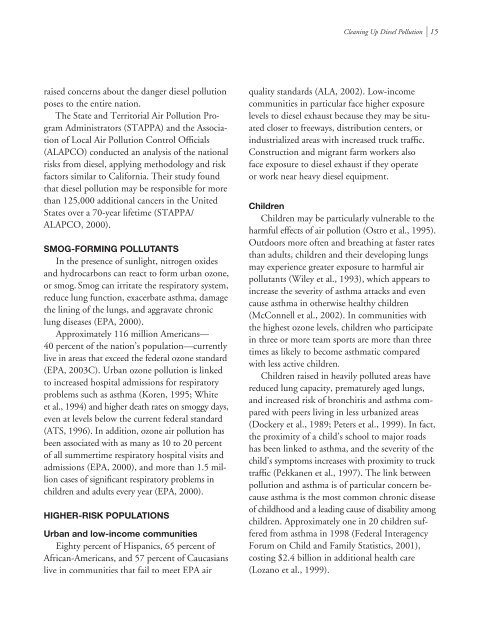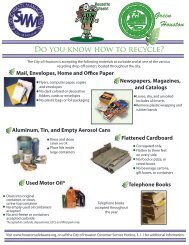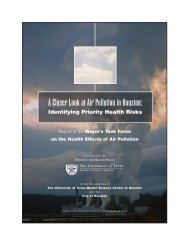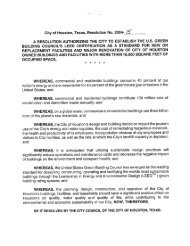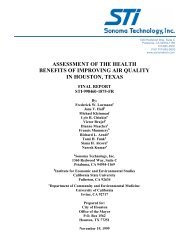Cleaning Up Diesel Pollution - Union of Concerned Scientists
Cleaning Up Diesel Pollution - Union of Concerned Scientists
Cleaning Up Diesel Pollution - Union of Concerned Scientists
- No tags were found...
You also want an ePaper? Increase the reach of your titles
YUMPU automatically turns print PDFs into web optimized ePapers that Google loves.
<strong>Cleaning</strong> <strong>Up</strong> <strong>Diesel</strong> <strong>Pollution</strong> l 15raised concerns about the danger diesel pollutionposes to the entire nation.The State and Territorial Air <strong>Pollution</strong> ProgramAdministrators (STAPPA) and the Association<strong>of</strong> Local Air <strong>Pollution</strong> Control Officials(ALAPCO) conducted an analysis <strong>of</strong> the nationalrisks from diesel, applying methodology and riskfactors similar to California. Their study foundthat diesel pollution may be responsible for morethan 125,000 additional cancers in the UnitedStates over a 70-year lifetime (STAPPA/ALAPCO, 2000).SMOG-FORMING POLLUTANTSIn the presence <strong>of</strong> sunlight, nitrogen oxidesand hydrocarbons can react to form urban ozone,or smog. Smog can irritate the respiratory system,reduce lung function, exacerbate asthma, damagethe lining <strong>of</strong> the lungs, and aggravate chroniclung diseases (EPA, 2000).Approximately 116 million Americans—40 percent <strong>of</strong> the nation’s population—currentlylive in areas that exceed the federal ozone standard(EPA, 2003C). Urban ozone pollution is linkedto increased hospital admissions for respiratoryproblems such as asthma (Koren, 1995; Whiteet al., 1994) and higher death rates on smoggy days,even at levels below the current federal standard(ATS, 1996). In addition, ozone air pollution hasbeen associated with as many as 10 to 20 percent<strong>of</strong> all summertime respiratory hospital visits andadmissions (EPA, 2000), and more than 1.5 millioncases <strong>of</strong> significant respiratory problems inchildren and adults every year (EPA, 2000).HIGHER-RISK POPULATIONSUrban and low-income communitiesEighty percent <strong>of</strong> Hispanics, 65 percent <strong>of</strong>African-Americans, and 57 percent <strong>of</strong> Caucasianslive in communities that fail to meet EPA airquality standards (ALA, 2002). Low-incomecommunities in particular face higher exposurelevels to diesel exhaust because they may be situatedcloser to freeways, distribution centers, orindustrialized areas with increased truck traffic.Construction and migrant farm workers als<strong>of</strong>ace exposure to diesel exhaust if they operateor work near heavy diesel equipment.ChildrenChildren may be particularly vulnerable to theharmful effects <strong>of</strong> air pollution (Ostro et al., 1995).Outdoors more <strong>of</strong>ten and breathing at faster ratesthan adults, children and their developing lungsmay experience greater exposure to harmful airpollutants (Wiley et al., 1993), which appears toincrease the severity <strong>of</strong> asthma attacks and evencause asthma in otherwise healthy children(McConnell et al., 2002). In communities withthe highest ozone levels, children who participatein three or more team sports are more than threetimes as likely to become asthmatic comparedwith less active children.Children raised in heavily polluted areas havereduced lung capacity, prematurely aged lungs,and increased risk <strong>of</strong> bronchitis and asthma comparedwith peers living in less urbanized areas(Dockery et al., 1989; Peters et al., 1999). In fact,the proximity <strong>of</strong> a child’s school to major roadshas been linked to asthma, and the severity <strong>of</strong> thechild’s symptoms increases with proximity to trucktraffic (Pekkanen et al., 1997). The link betweenpollution and asthma is <strong>of</strong> particular concern becauseasthma is the most common chronic disease<strong>of</strong> childhood and a leading cause <strong>of</strong> disability amongchildren. Approximately one in 20 children sufferedfrom asthma in 1998 (Federal InteragencyForum on Child and Family Statistics, 2001),costing $2.4 billion in additional health care(Lozano et al., 1999).


